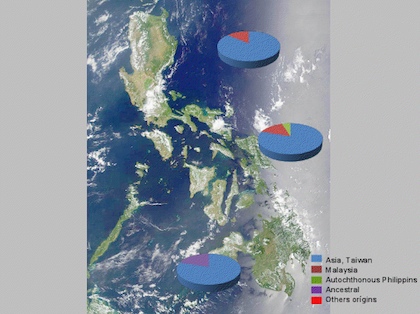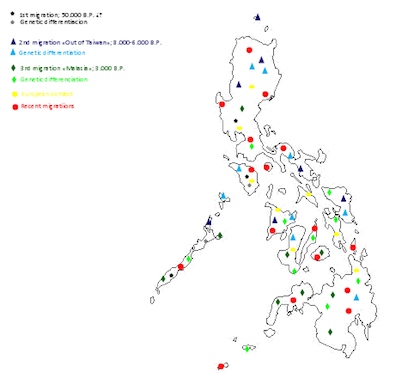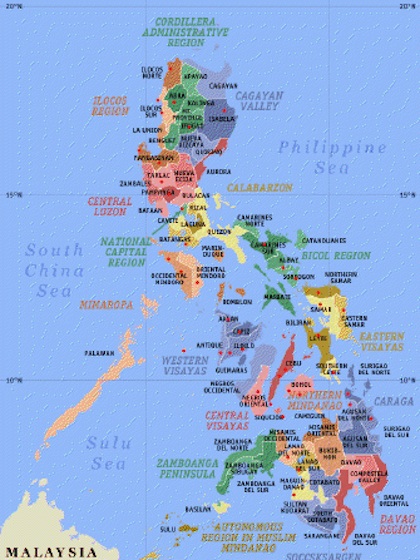SUMMARY
This is AI generated summarization, which may have errors. For context, always refer to the full article.

MANILA, Philippines – A majority of Filipinos today come from populations that migrated to the archipelago some 6,000 years ago from mainland China and Taiwan, according to initial findings of a Spanish biologist who is studying the historical evolution of the genetic diversity of the Philippines.
Less than 25% are of Malay extraction, ancestral or indigenous origin in their female lineage, the DNA components inherited from the mother and grandmother, the initial findings of Spanish biologist Antonio Gonzalez-Martin show.
Gonzalez-Martin unveiled on Tuesday, July 24 the results of an ongoing scientific investigation about the genetic history of Filipinos and how human migration has affected the demographics of the Philippines, where whatever anyone may think or be willing to admit, “everyone is a mestizo.”

Rough approximation
Gonzalez-Martin clarified that his initial findings are just a rough approximation to a theory about the genetic makeup of Filipinos, as his initial findings come from 100 saliva samples taken from volunteers at hospitals all around the country and among the Filipino community in Madrid.
“I cannot tell what percentage of Chinese or Malay is in the average Filipino, that’s too risky to say,” he told Rappler.
The results also do not imply that most Filipinos are actually Chinese.
“From what we have seen so far, an important part of the maternal lineage is connected to groups that migrated from China or Taiwan between 4,000 and 6,000 years ago, when the modernization of crop systems created a food surplus that fueled migration” to Southeast Asia, said Gonzalez.
But even if these settlers were in fact Chinese, their DNA evolved and mutated over thousands of years and adapted to the climate so they are genetically different to the Chinese who arrived in the Philippines more recently or even in the Spanish colonial times.
Those changes, however, are almost imperceptible and can only be traced with the most advanced molecular technology.

Maternal lineage
Gonzalez-Martin, a professor of Biology at the Complutense University in Madrid, stressed that these results are only his initial findings and he needs more time to complete his research.
For instance, at this stage he has only analyzed the mytochondrial DNA or maternal lineage of the subjects, which explains for example the fact that he has not yet encountered any European genes.
“We have not found any trace of european ancestry so far, but we will. The human expansion model throughout History has been either commercial or military. Men would travel while the women were left at home” so the results will be different after he collects data on the paternal lineage, he said.
PH has ‘unique’ historical-genetic map
Gonzalez-Martin highlighted that he chose the Philippines for this project because the country has a very rich demographic history and “unique” historical-genetic map.
“What makes the Philippines interesting is how its population has been influenced by four waves of migration, unique in the world. It is truly one of the most genetically diverse countries in the world.”

About 40,000 years ago, the first migrants, possibly the Negritos, arrived in the archipelago from Africa.
It took another 34,000 years for the next big wave of settlers to come from China and Taiwan, and 3,000 years later there was another surge in migration from present-day Malaysia and peninsular Southeast Asia in general.
While the Chinese migrants settled throughout the whole country, the Malays found their home mostly in Visayas and Mindanao, and the new migrants that came after the arrival of the Spanish can now be found everywhere throughout the country.
We are ‘all mestizos’
All of this is proof, according to Gonzalez-Martin, that there is no such thing as being 50% Filipino and 50% anything else, because we are all a mix of the same genes. (Read: Of half bloods and hypocrisy)
“The concept of race has been used to separate, to marginalize, to make groups of people different and exclude ones from others,” he said.
But human beings are much more alike than we think, and scientists don’t believe in the concept of race.
“We are just groups of people, with very slight differences among each other. Those differences are just genetic mutations over time, but in essence we are all the same.”
Gonzalez-Martin added: “Race simply does not exist as a biological concept, and ethnicity has more to do with cultural affinity.”
In the Philippines, as in almost anywhere else around the world, “we are all mestizos because no single population has been completely isolated” from the rest. – Rappler.com
Add a comment
How does this make you feel?
There are no comments yet. Add your comment to start the conversation.